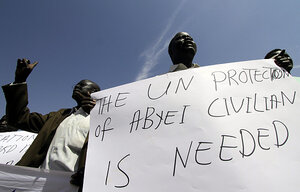'Oil-rich' Abyei: Time to update the shorthand for Sudan's flashpoint border town?
Read any of the media coverage of Abyei and you’ll be hard-pressed not to find the phrase 'oil-rich' placed somewhere in front of the town’s name. But these days the accuracy of the journalistic short-hand is questionable.

People from the Dinka tribe hold placards during a demonstration calling for the immediate formation of the Abyei oil region referendum commission and protesting against the settlement of the Massireya tribe in their area on Sept. 23, 2010. Sudan still has to name a commission to organise a referendum on whether the central oil-producing region of Abyei should remain in north Sudan or join the south, a vote due to take place on January 9, 2011.
Mohamed Nureldin Abdallah/Reuters
Abyei, Sudan
The failure to agree on who gets to vote in a Jan. 9 referendum on whether the key strategic Sudanese town of Abyei will remain part of northern Sudan or become part of what could be a newly independent south is leading pundits to cite Abyei as a possible trigger for a return to war.
Accordingly, the number of articles on the Abyei referendum has sky-rocketed. Read any of the media coverage and you’ll be hard-pressed not to find the phrase “oil-rich” placed somewhere in front of the town’s name. But these days the accuracy of the journalistic short-hand is questionable.
In 2004, when the final stages of the negotiations for the Comprehensive Peace Agreement were underway, the Abyei area was indeed “oil rich.” There were two major oilfields to the east of Abyei town, Heglig and Bamboo, and another to the north called Diffra.
Back then, the combined production of the three fields was an estimated 76,600 barrels per day (bpd). If you crunch the numbers, this amounted to 25 percent of Sudan’s annual oil production. With so much at stake, “oil-rich” summed up perfectly the reasons why Abyei was an obstacle to the conclusion of the peace agreement.
But we are now in 2010. In the intervening six years, two factors have diminished the accuracy of the “oil-rich” label:
First, oil production from Heglig, Bamboo, and Diffra has declined across the board. From the 76,600 bpd of 2004, the 2009 estimates for the three fields dropped to 28,300 bpd. Meanwhile, production from outside the area increased. By early 2009, “oil-rich” Abyei only accounted for 5 percent of Sudan’s annual production.
Second, a July 2009 ruling by the Permanent Court of Arbitration, placed Heglig and Bamboo outside of Abyei. Of course these two fields are still physically in the broader border region, and the dispute between north and south over who will benefit from them continues. But they are no longer up for grabs in the Abyei referendum, which is what most reporting on Abyei is about. The only oilfield now remaining in the Abyei equation is Diffra, estimated to have produced just 4,000 bpd in 2009 – less than 1 percent of Sudan’s current annual production.
According to Rosie Sharp from Global Witness, some oil has been found beyond Diffra, “but it's not clear whether the quantities are commercially-viable.” Given the possibility that Abyei has more usable oil than we currently know or can verify, one may argue there is no harm in continuing to label Abyei as “oil-rich.” But the problem is that as long as oil remains the primary lens through which Abyei stories are packaged, we miss what else is at stake.
Abyei is extraordinarily fertile, and the significance of the River Kiir (in Dinka)/Barh el-Arab (in Arabic) to the sustenance of life here cannot be overstated.
This river continues to flow throughout the harsh dry season, meaning it is the only place to graze livestock for many months of the year. Without it, the nomadic population could not survive. Even if it turns out there is untapped commercially-viable oil within Abyei’s boundaries, that still only accounts for one strand of what is going on in Abyei.
At the national political level, oil matters.
For the people who live here – who have never seen any benefits from oil and don’t believe they ever will, the talk of oil just feels like a headache they would rather do without. But if you took oil out of the equation you would still have a very big Abyei problem – primarily because of water, but also because of the political manipulation of local actors, and the legacy of war on inter-ethnic relations. None of these issues are getting the coverage they deserve because of the hyped-up focus on oil.
– Rebecca Hamilton, a fellow at the New America foundation, is reporting from Sudan with support from the Pulitzer Center on Crisis Reporting.
